AudioArt No.174 - 2003 - Taiwan


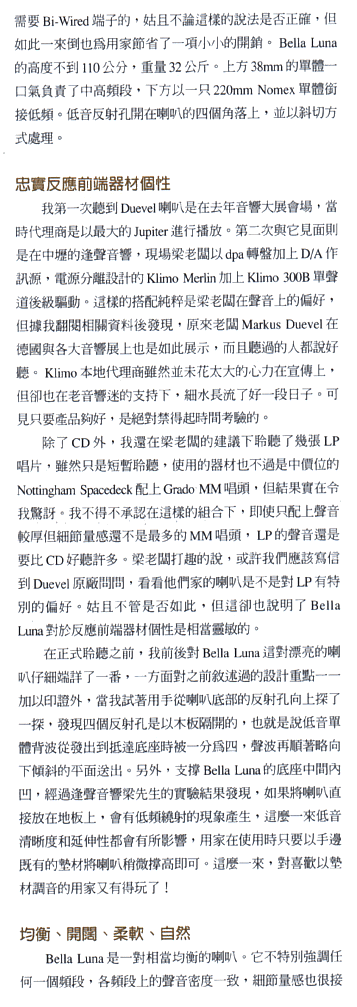
The Reference Stereo Imaging
Duevel Bella Luna Loudspeaker
Duevel is a German company, the scale of which is not large, yet in recent years their several loudspeaker products received unanimous agreement from the attendants to the Frankfurt HighEnd Exhibition. Currently they have three models in their catalog - Venus is the basic model with the lowest profile and electro-mechanic efficiency, but it can deliver a wide sound spectrum from 40Hz to 20kHz with ease. The mid model, Bella Luna, is our spotlight in this review; the top model is Jupiter, with a height of 130cm and weight of 70kg, a sovereign full range loudspeaker.
--Research, Development and Manufacturing, All on Their Own--
The three models mentioned above have a common feature - they are all two-way two-unit and floor-standing design. The sound is reproduced via a tweeter at the top facing downward and a woofer at the middle facing upward. Both high and low frequency then flow out along one or two wooden discs. The three models mainly differ in the size of driving units, the volume of cabinets, the power handling limits and the integrity of sound spectrum. Their cabinet structure and the eye opening wooden disc are all hand made with the same high quality.
The wooden texture of Bella Luna looks and even feels very familiar to me. It turns out to be that Mr. Mark Duevel, the owner of Duevel, has designed many products for other Hi-End audio companies since 1988, when he founded Duevel. The cambered wooden disc on the top of Bella Luna is the heart of all the three Duevel loudspeaker models. Now let's have some talk about the original design concepts of Duevel.
The Omni-Directional Reflector, Which Let Loudspeaker to Reproduce Sound to 360° The ideal sound reproduction is via the inflation and deflation of a sphere-shaped unit, so as to extend sound to all directions. This kind of idea has been proposed since more than 20 years ago. Lots of experiments have been done but no practical implementation has been achieved. Currently most loudspeakers are still designed to be a point source or linear source. Linear sources have better horizontal extension; they often sound relaxing, but sound image focusing is their weakness. On the contrary, point sources radiate sound waves uniformly from a virtual spherical surface. They normally have better vertical extension than horizontal extension, and they often have better focusing. Unfortunately, ordinary loudspeakers suffer from unavoidable diffraction, so they cannot achieve an ideal point source, and thus they often have "sweet-spot" listening positions.
Omni-Polar was originally the registered trademark of Mirage Loudspeakers. Mirage placed the same driving units both at the front and at the back of loudspeaker cabinets and fed them with in-phase signals. After all, Mirage's Omni-polar still cannot achieve a 360-degree ideal spherical sound reproduction. Before Duevel's loudspeakers enter the market, we've seen a 360-degree sound reproduction loudspeaker - mbl 101. It can create such an astonishing three-dimensional sound stage, and thus it is also very expensive. I believe that Markus Duevel is absolutely a genius; I don't know where his inspiration came from, but de did think out this cost-effective omnidirectional design. The disc-shaped device extends both high and low frequency energy evenly towards every direction and eliminates the point directional problem of all driving units. Duevel names the device "Omni-Directional Reflector."
--Point Source with Consistent Phase--
Actually the Omni-Directional Reflector is basically a extended form of the conventional horn. It can be viewed as two parts. The upper part is a wooden horn facing downwards, while the lower part is shaped like an awl. When producing sound, high frequency waves pass through the small-calibered aluminum part to be somewhat compressed and then be sent out through the wooden horn. Low frequency waves take the opposite way. They flow along the gently curved surface of the lower awl-shaped part. Highs and lows join together at the edge of the disc and become an ideal point source without any phase inconsistency.
Observing Bella Luna's Omni-Directional Reflector at a very short distance, we can also find a protruding circular soft pad. I don't know the purpose of this soft pad. Maybe it is to scatter sound waves due to that the wiring of the tweeter is placed outside. Duevel's loudspeakers are not equipped with bi-wire connectors. Of course this is nothing special - we can also find the same design on other speakers such as Thiel and Dynaudio. As Jim Thiel has ever said, "well-designed speakers don't need bi-wiring." Whether true or not, this saves some money for the user. Bella Luna is less than 110cm tall and weighs 32kg. The 38mm unit at the top takes the whole mid and high frequency range. Underneath it, a 220mm Nomex woofer is in charge of low frequency. Reflex ports are placed at the four corners of the speaker.
-Faithfully Reflects the Characteristics of Front-end Equipments-
The first time I heard the sound of Duevel loudspeakers was last year, at the annual high-end audio exhibition. At that time the distributor was demonstrating with the largest model, Jupiter. The second time I met Duevel speakers was at the Fong-sheng Audio in Chung-li. The owner, Mr. Liang used dpa transport and a D/A converter as the signal source, and Klimo Merlin and Klimo 300B mono blocks were the amplifiers. The combination was Mr. Liang's personal preference, but after I did some research, I found that Mr. Markus Duevel also uses this set of equipments for demonstration at the many large audio exhibitions in Germany. Although Klimo's distributor in Taiwan doesn't put much effort in advertising, Klimo still has lived for a long period of time. It is thus evident that a product surely won't fade out with time as long as it is good enough.
In addition to CDs, I also listened several LPs. Despite not a very long term listening and the equipment merely mid-end Nottingham Spacedeck with Grado MM phono cartridge, the result sound was very surprising. I must admit that with such a combination, even with a less-detailed MM cartridge, LPs sounded far better than CDs. Mr. Liang made a fun comment that maybe we should mail to Mr. Duevel asking him if Duevel speakers have a favor to LPs. No matter what, this experience indicated that Bella Luna is very sensitive to the characteristics of the front end equipments.
--Balance, Wide, Soft, Natural--
Bella Luna sounds very balanced. It doesn't put emphasis on any particular frequency range. All frequency bands have the same density of sound and the same detail. Bella Luna is like an artfully cup of Cappuccino. It puts away the strong stimulation of Espresso, and it also avoids the milky sweetness of Latte - in addition to the proper balanced mixture of coffee and milk, Bella Luna decorates the milk bubble with a beautiful flower.
The "Good Vibrations" of King's Singers is a good example. Singers of different parts are perfectly positioned, and the voices are rich and mellow. The notes are vividly expressed one after another. The arrangement is so clear as if you can see it right in front of your eyes. There are quite many loudspeakers that are balanced in all frequency bands, but few are as soft, smooth, wide and natural as Bella Luna.
To reproduce Jazz music beautifully, a loudspeaker needs not only softness and denseness but also tenaciousness in mid-low frequencies. Jacques Loussier Trio's "Baroque Favorites" (TELARC CD-83516) contains simply few instruments. Piano, bass and Jazz tomtom cover almost all frequency bands. Bella Luna doesn't give an "Armageddon" impact, but every drumbeat is considerably jumpy and energetic. Cymbals reverbs and details also appear very clear thanks to Bella Luna's superior resolution.
High frequency extension is also one of Bella Luna's strong points. Akiko Suwanai's violin has a unique feminine tenderness. When I listened to her playing Brahms' "Hungarian Dances" (Philips 462621-2), I found the clearness I've never heard. I can feel the sweetness from both the piano and the violin. Unequaled smoothness of high frequency and richness of overtones plus revealing details, Bella Luna is so splendid as if a super tweeter were attached to it. Such natural and beautiful high frequencies are certainly unforgettable.
--Reference Positioning and Imaging--
According to the manufacturer's recommendation, it is best to adopt regular triangular placement method for Bella Luna. Get at least 1.5 meters away from walls. Once the placement is properly done, the sound stage and image will focus very clearly, and even if you walk around when listening to music, the sound imaging still doesn't move a bit. Not only the position but the size is the same. With such outstanding performance, Bella Luna is the only one qualified to be the reference of stereo sound imaging.
--The Shortcut to Beautiful Sound--
I have ever visited many stereophiles. They have various equipments, and those equipments are often very expensive. However, most of them are not properly installed and/or adjusted and thus don't reproduce good sound. When the audio system gets more and more complicated, there are more and more variables that can affect the sound. It is really difficult to get control over all those variables. Actually, it is not difficult to get good sound. What is difficult is to have stereophiles let go their prejudices. Just accept a few principles: simple, balanced and natural. This is well proven in this listening test. Duevel Bella Luna matched up with Klimo amplifiers gives such delicate, graceful, relaxing and natural sound. Is it so difficult to get beautiful sound? Let Bella Luna show you the shortcut o it!
